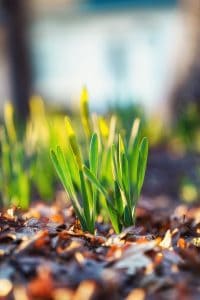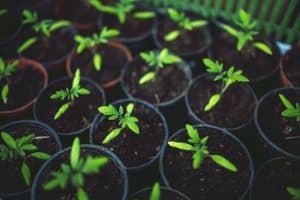So, it’s time to roll up your sleeves and do some planting around the house. You may be wondering to yourself how close you can plant to your house? Is there an optimal distance that benefits both your house and your plants? Planning and understanding the proper spacing keeps your home and garden in your best interest! If you don’t plan ahead and properly space your plants from your home, you can cause severe damage to your property. Here is all you need to know when planting near your house!
How Far Should Plants be From Your Home?
So, how far should plants be from your home? You can’t just plant your trees and shrubs anywhere. The space between your plants and your house depends more heavily on the distance between the plants and your home’s foundation. It will also vary depending on the type of plant, how large it will become as it matures, and the aesthetic you want.
Proper spacing is essential to any home, and every homeowner should know best practices when planting. Spacing isn’t an exact science and can depend significantly on several variables. Not every plant needs the same amount of spacing or treated the same. The spacing of your plants is crucial for many different reasons. Proper spacing allows for the full development of your plants without crowding other plants, your house, or other structures. When planting, you want to consider these things because the size of a plant will change as it grows. Spacing also depends on how far you want a plant to mature and how you will prune it.
Planning Ahead
When you plant in your yard, you want to make sure you plan carefully. Adding plants, shrubs, and trees is a superb way to spruce up your home. However, every plant is different and requires different needs to thrive, not just survive. More importantly, every plant is unique in the spacing it requires. This includes room to mature.
You should also measure your property’s slope. It’s best if your home has proper grading, the slope of the elevation slopes downward and away from your home. Proper grading should have a rate of one inch per foot for the first 6 feet and then a continued slope for about 10 feet from the foundation. Grading is also vital in the flow of water away from your home.
To calculate the grading, you don’t have to do complicated math or hire a professional. You can hire a surveyor if you’d like. However, it should be easy to calculate just by looking at it. If the ground is flat near and around your house, you should consider working on proper grading before you plant. You can also tell if your yard needs grading work by observing how flooded it gets when it rains.
Dangers of Planting Shrubbery Too Close to Your Home
You can’t plant too close to a structure, not only because plants can potentially come into contact with the siding and damage it, but because plants hold a lot of moisture. The main issue with planting shrubbery near or on your house or structure is moisture. Moisture increases the rate of deterioration of almost every exterior.
It can also attract unwanted bugs and pests and provides them with plenty of food. Termites are innately attracted to moist, damp areas. Termites are more interested in deadwood and other building materials, but they can also eat the roots of live shrubbery and trees. Also, termites are migratory and can easily be led to eat away at your home.
You can use poultry netting, commonly known as chicken wire to protect your plants from pests. This versatile product can be cut and placed anywhere. You should install it around a garden’s perimeter or on individual plants to prevent rodents or birds from accessing them. However, it is important to ensure that the netting is installed at a safe distance from the house to avoid any damage to the foundation or other structures.
Smaller shrubs can grow exponentially fast and turn into enormous bushes. When plants are planted too close, houses become covered and are quickly overgrown. That’s why it is crucial to consider the mature size of the plants when you choose the location. It’s easy to miscalculate and plant too close to your home, so be cautious with the distance you plant your shrubs and trees.
Small shrubs should be planted at least two feet from your house foundation. Medium shrubs should be about three feet from the foundation. Tall shrubs are recommended to be about four to five feet away. You don’t want tall shrubs near the foundation to exceed the height of your roof’s eaves. This can cause damage to gutters. Tall shrubs are ideal for planting on the corners of your foundation.
As a general rule of thumb, you should plant shrubs by at least half the distance of their mature spread from your house’s foundation. For example, if a shrub will grow to be 20 feet wide, you will want it at least 10 feet from your home. You will also want to consider the mature height as well as the windows of your structure.
Dangers of Planting Trees Too Close to Your Home
Planting trees too close to structures can be just as harmful as shrubs. It can be detrimental to your home. Planting trees can cause different types of issues, including:
- Structural Damage- Tree roots can cause structural damage depending on the type of tree and on how close it is. Certain trees have very aggressive roots. Some trees cause less harm because their roots go around things that obstruct them.
- Plumbing Damage- Tree roots can cause plumbing problems by boring through older plumbing structures like clay and cast iron. More massive roots can also crush plumbing or block drainage.
- Roofing Damage- Tree limbs that hang over your house are potential accidents waiting to happen. Contact with tree limbs and debris can accelerate the erosion of your roof.
- Heaving Damage- Tree roots can often damage walkways and driveways. These roots not only damage concrete and asphalt, but also create hazards to people’s health. These roots cause issues that are easy to trip over due to uneven surfaces.
It’s best to give trees 15 to 20 feet of space from your home or any structure. You can also talk to a professional like someone at a local nursery to learn more about different trees’ root systems. Hard-wood trees should be planted no closer than 20 feet from the house. Soft-wood trees should be planted even further. If a tree matures and becomes large, the distance should be about 50 feet from each other. Smaller trees should not be planted closer than eight feet from the foundation of the house.
Proper Drainage
It is also critical to your home’s health to keep it dry. The best way to do this is to avoid structural deterioration from water by ensuring your home has proper drainage. Landscaping plays a vital role in helping keep your home dry. Specific types of plants can help water to be soaked up by your plants, shrubs, trees, and lawn. This can help keep your lawn soft and beautiful. If you don’t maintain proper landscaping, it can lead to water penetration issues on your property.
A Few Things to Consider When Spacing
Will you be washing the windows that are behind your foundational plantings. If you are, you should leave about three feet of space from the front, side, or back wall of your house, and the edge of your estimated mature bushes will be. This allowed space should also leave enough room for a ladder.
You should also consider the drip edge and overhang. When it rains, water rolls down the roof and falls off the edge of your house. Unless you have gutters to allow for drainage, the water will fall right into your bushes and plants. This direct water can cause damage and erode the soil. Even with gutters, icicles can form and cause drip just the same. When you plant, you should always plant them so their mature backs are past the drip edge.
When thinking of how far to plant, consider the width and height the bush will grow to be. Make sure to check the plant tag to see how wide and tall the plant grower thinks it will get to be. The number listed on the label is just an average and will not take into account whether or not the plant will like where you grow it. Don’t just take the tag’s word for granted. Make sure you also talk to a professional at a garden center or nursery to get their opinion.
Plants also need plenty of space for proper airflow and light. Evergreens especially need air movement and light to stay healthy on all sides. If they are too close to a building, they will not get enough light on the side facing your house. The side that doesn’t get enough light will eventually die off.
Annuals vs. Perennials
When planting, you may want to consider having plants that fit your home’s needs. Do you want annual plants or perennials? That’s for you to decide! Annual plants have a life cycle of one year and need to be replanted each spring. For the most part, annuals bloom for a long time and have beautiful colors. Perennials last for more than two years and return year after year until they are mature. The average is about three to five years, but this varies by plant. Perennials also bloom for a shorter time.
No matter what you decide to plant, it’s essential to plan beforehand. You should consider spacing from your home based on the foundation, type of plant, the mature size of the plant, and the landscape.
If your looking to plant a tree read our article on how far to plant a tree from your house.



